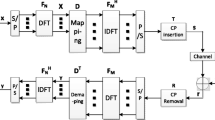Abstract
Considering practical constraints in the single-carrier frequency division multiple access system, this paper proposes a jointed resource allocation and multiuser pairing algorithm with low complexity. It initially schedules the first user and carries out resource allocation and then selects the second and following pairing users in turn. Meanwhile, the proportional fair criterion is considered independently in the scheduling process for every pairing user. The simulation results show that, excluding its considerably lower complexity, the proposed algorithm has better throughput and fairness than the existing algorithms.









Similar content being viewed by others
References
3GPP TS 36.201 V8.3.0 (2009–03). Evolved universal terrestrial radio access (E-UTRA); LTE physical layer-general description(Release 8).
Kumar, A., Sengupta, J., & Liu, Y. (2012). 3GPP LTE: The future of mobile broadband. Wireless Personal Communications, 62(3), 671–686.
Madan, R., & Ray, S. (2011). Uplink resource allocation for frequency selective channels and fractional power control in LTE. In Proceedings of IEEE ICC, pp. 1–5.
Ahmad, A. (2014). Resource allocation and adaptive modulation in uplink SC-FDMA systems. Wireless Personal Communications, 75(4), 2217–2242.
Prasad, N., Zhang, H., Zhu, H., & Rangarajan, S. (2012). Multi-user scheduling in the 3GPP LTE cellular uplink. IEEE Transactions on Mobile Computing, 99, 1.
Lee, S., Pefkianakis, I., Meyerson, A., Xu, S., & Lu, S. (2009). Proportional fair frequency-domain packet scheduling for 3GPP LTE uplink. In Proceedings IEEE INFOCOM (pp. 2611–2615).
Lim, J., Myung, H. G., Oh, K., & Goodman, D. J. (2006). Proportional fair scheduling of uplink single-carrier FDMA systems. In Proceedings IEEE PIMRC, pp. 1–6.
Chen, X., Hu, H., Wang, H., Chen, H. H., & Guizani, M. (2008). Double proportional fair user pairing algorithm for uplink virtual MIMO systems. IEEE Transactions on Wireless Communications, 7(7), 2425–2429.
Kim, J. W., Hwang, I. S., & Kang, C. G. (2010). Scheduling for virtual MIMO in single carrier FDMA system. In Proceedings IEEE ICTC, pp. 115–119.
Fan, J., Li, G. Y., Yin, Q., Peng, B., & Zhu, X. (2012). Joint user pairing and resource allocation for LTE uplink transmission. IEEE Transactions on Wireless Communications, 11(8), 2838–2847.
Couillet, R., Hoydis, J., & Debbah, M. (2012). Random beamforming over quasi-static and fading channels: A deterministic equivalent approach. IEEE Transactions on Information Theory, 58(10), 6392–6425.
Choi, J., Kim, Y. H., Lee, J. H., Bahk, S., & Kim, S. C. (2012). User throughput estimation for the PF scheduling algorithm under MIMO channel environments. IEEE Wireless Communications Letters, 1(5), 528–531.
Author information
Authors and Affiliations
Corresponding author
Rights and permissions
About this article
Cite this article
Zhao, H., Ma, S., Liu, F. et al. A Jointed Resource Allocation and Multiuser Pairing Algorithm with Low Complexity for SC-FDMA Systems. Wireless Pers Commun 79, 2227–2236 (2014). https://doi.org/10.1007/s11277-014-1982-x
Published:
Issue Date:
DOI: https://doi.org/10.1007/s11277-014-1982-x




